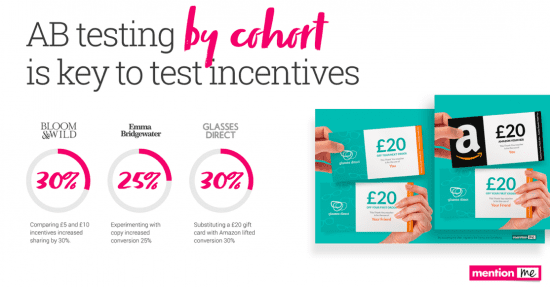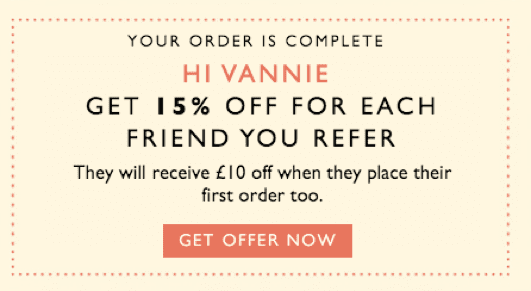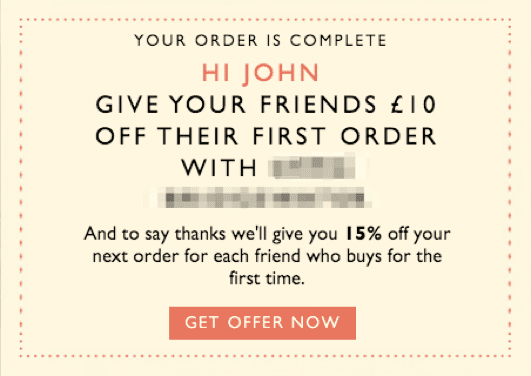What is referral marketing?
Essentially, referral marketing is about enabling and incentivizing your existing customer base to encourage their friends and family to try your product for the first time.
It represents a significant opportunity for most online businesses to boost their customer acquisition.
There are some well-documented examples of businesses that have acquired a huge percentage of their customers via referral. It is reported that for Dropbox it represents 35% of new customers and daily bookings tripled for Airbnb when they introduced a referral programme.
Whilst these figures might seem unattainable for established online businesses, our experience suggests that targeting 10-25% of new customer growth from referrals is realistic. Figures not to be sniffed at.
After all, there aren’t many other marketing channels that you could switch on and deliver that kind of an increase in acquisition.
The hidden benefits of referral
Whilst the main benefit of referral is the number of new customers that it can deliver to your business, there is a secondary benefit you might not have considered. The quality of customers that are delivered.
Some channels tend to attract discount hunters who are not in your target demographic and likely to only buy once. In contrast, referred customers are the friends of your existing customers, so they are a great match for your target market and tend to become great, longstanding customers.
They’re also predisposed to liking you as a brand before they’ve even bought anything because their friends have been enthusing about you to them.
As a result, from the data we have seen:
- They spend more on their first order - typically 15-25% more
- They have a higher lifetime value, up to 200% that of customers who come in from other channels
- They are three times more likely to become a referrer themselves
Is referral right for your brand?
Whilst there are no hard and fast rules as to what type of businesses can benefit from referral, there are some key factors to consider:
Underlying customer satisfaction
The happier your customers are with your product the more likely they are to tell their friends. A high Net Promoter Score (NPS) is a great indication that referral has the potential to work well.
Demographic
Referral can work for any demographic but some tend to be more active. Women tend to share more than men and under 30s share more than over 30s. That’s only part of the story. Whilst the older demographic tends to share less, the shares they make tend to convert better.
Talkability of the category
Some categories lend themselves to discussion. Fashion and holiday plans are often discussed with friends, hobbies are shared with other enthusiasts. Unique or new products often spark a conversation. If this dynamic is present it increases the share rate.
Impulse or considered purchase
If your product requires consideration it will take longer to get a referral programme off the ground as friends who receive a recommendation may not yet be ready to buy. But the seed of consideration will have been sown.
Discounting environment
Does your brand discount heavily? This might make it difficult for the referral offer to stand out. If it is less generous than other offers in the marketplace then referrers are unlikely to share it with their friends.
Economics
You need sufficient gross margin for the referrer and the referee incentives to fit within your Cost Per Acquisition. If you can’t offer a compelling incentive out of the margin you have available then incentivized referral won’t work.
Knowing that your brand has the right attributes for happy customers to share with their friends is a great first step; However, the right combination of offers, messaging and psychological triggers takes referral to a whole new level.
Here we consider the elements to consider to ensure that your programme is a success.
Social interaction is at the core of referral
When people initially think about referral marketing they tend to focus on the incentives and ease of use as the key drivers of success.
Although these are important, it is the psychology of referral and a customer’s relationship with their friends that have the biggest impact on whether a brand is shared.
If the referral makes someone look good because they’re introducing a brand or offer that their friends will love, then their friendship will benefit from the referral and their social capital increases.
Conversely, if the referral risks making them look like they’re acting in their own self-interest then most customers won’t risk a friendship by sharing an offer with their friends. There is too much social risk.
The key determinant of how people think about the social capital and the social risk components comes down to how the referral offer is positioned and how they view the brand.
The psychology of referral is a huge topic and one we cover in a previous post.
Encourage referral at the point of customer delight
When promoting referral there should be three ambitions:
- To get as close to the point of delight as possible
- To keep the programme top of mind
- To enable customers to easily find it if they look for it
Make it easy for your customers to tell their friends
The basic rule here is that you should enable your customers to share however they want to. The sharing options we find most successful are:
Face-to-face
This is where most conversations about a brand happen. Capturing these face-to-face referrals can be difficult where a referral scheme requires a link. Something we’ve developed which is extremely successful is the ability for customers to share using their name. This means a referred friend can visit the site and just enter the referrer’s name in order to receive their introductory offer.
Unique sharing URL
Each customer gets their own unique sharing URL that they can post wherever they like: in an email, on social media on a blog.
Email
Allowing people both to send an email from the share page with the option to look up their friend’s email addresses and giving them an email they can forward on to their friends later on.
Social
Establish which social channels your target demographic uses. Typical sharing channels include Facebook (directly or on their timeline), Twitter, WhatsApp or Weibo (for the Chinese market).
Test to find the right referral incentives
Testing improves results. Sounds obvious, right? With referral, it is more complicated than it first sounds.
AB testing by cohort
If you show an offer to a cohort of customers for a month and then want to test a different offer, it would be a very poor user experience to just switch out the offer that referred friends of the first cohort are expecting.
To avoid this, you need to be able to conduct AB testing by cohort so that you can offer consistency of experience to each cohort. This is particularly important when the point of purchase may be some time after the initial referral.

Value of referral offer
Your underlying economics will determine how much you can afford to give away. The referral incentive should always be better than offers that the referrer or their friend could get through other channels. Otherwise the customer feels like they’re doing their friend, or indeed themselves, a disservice in sharing it.
Businesses that get referral to work often find that they can offer deeper incentives than for other channels; Since referred customers tend to spend 15- 25% more on their first order and have double the lifetime value, they can afford a higher cost per acquisition for referred customers.
How to split the incentives
A balanced offer between the referrer and their friend is best. If you are generous to the referrer but not to the friend then the referrer risks feeling like they’re taking advantage of their friendship and may not share. If you’re generous to the friend but not the referrer, it makes the referrer question why their friend can get a better deal on your site even though they themselves are already a loyal customer.
Test the order of incentives
Test how self-interested your customers are by framing the offer differently. Are they more likely to refer when they feel they are being generous of when they can see how they will benefit?
Option 1: Self-interested – “Get 15% off for each friend you introduce”

Option 2: Altruistic – “Get your friend £10 off their first shop”

This test often throws up interesting results.
The most effective incentives
Money off your own product or service tends to work best; customers understand it, they like your product or service enough to recommend it and so will probably want more of it. It also is likely to be more cost-effective for you as a business.
Where it isn’t appropriate because of your business model or other constraints then 3rd. party vouchers can work. Generally, the more liquid the voucher the better. In other words, Amazon works very well because it can be used universally online towards a wide range of products. The supermarkets and national brands are next most effective because people can envisage using the vouchers soon.
Interestingly, offering cash, the most liquid of rewards, tends to convert less well because it results in confusion. Customers don’t understand why you are offering them cash rather than credit towards your store, nor do they understand how you’d give it to them.
Launch it, prove it, promote it
It is worth recognizing that done correctly, referral can become a marketing channel that boosts acquisition by 10-25%. This warrants spending time and effort on it to enable it to reach its full potential. The launch is only the start. The real value comes from the marketing team working to optimise the channel over time.

Angela Southall is the Marketing Manager at
Mention Me, a trusted referral marketing software company that powers the
refer-a-friend programs for 200+ leading brands worldwide.






 Angela Southall is the Marketing Manager at
Angela Southall is the Marketing Manager at 


